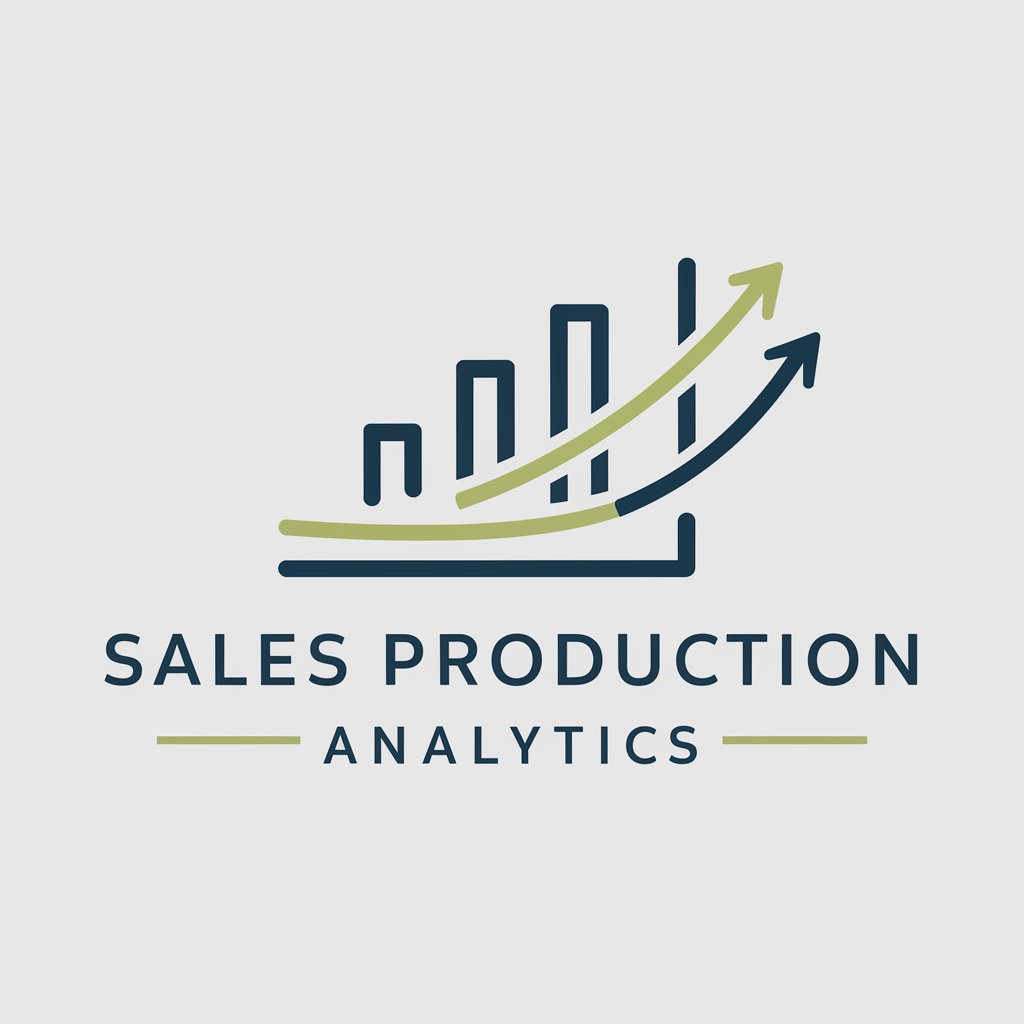
Sales Production Analytics - sales data insights tool

Welcome! Let's dive into your sales data.
Empower sales with AI-driven analytics
Analyze the sales data for the past quarter to identify trends in product performance.
Create a visual representation of sales growth over the last year.
Evaluate the effectiveness of recent marketing campaigns on sales numbers.
Compare the sales performance of different regions to determine areas for improvement.
Get Embed Code
Understanding Sales Production Analytics
Sales Production Analytics is designed to delve deeply into sales data, providing insightful analysis that goes beyond surface-level statistics. By utilizing advanced data processing and visualization techniques, it aims to uncover patterns, trends, and insights that can inform strategic decision-making. This system is built to handle various aspects of sales data, from volume and revenue to customer behavior and product performance. It excels in transforming raw sales numbers into actionable intelligence, helping organizations optimize their sales strategies and production processes. For example, a company might use Sales Production Analytics to analyze seasonal sales patterns, enabling them to adjust their inventory and marketing efforts accordingly. Another scenario could involve assessing the sales performance of different product lines to identify underperforming products that need strategic revamping. Powered by ChatGPT-4o。

Core Functions of Sales Production Analytics
Trend Analysis
Example
Identifying the rise in demand for eco-friendly products over the last quarter.
Scenario
A retail company utilizes trend analysis to allocate more shelf space to sustainable goods, based on the identified sales increase.
Performance Benchmarking
Example
Comparing sales performance of new product launches against established products.
Scenario
A tech firm employs performance benchmarking to evaluate the success of its latest smartphone release, comparing it to previous models' initial sales figures.
Customer Segmentation
Example
Segmenting customers based on purchasing patterns and product preferences.
Scenario
A fashion brand uses customer segmentation to develop targeted marketing campaigns for different demographics, improving engagement and conversion rates.
Sales Forecasting
Example
Predicting future sales volumes based on historical data and market trends.
Scenario
A food and beverage company forecasts next quarter's sales to adjust production levels and inventory, preventing stockouts or overproduction.
Visual Analytics
Example
Creating dynamic, interactive dashboards that display sales KPIs in real-time.
Scenario
A SaaS company implements visual analytics to provide executives with an at-a-glance overview of global sales performance, enabling quick, informed decisions.
Who Benefits from Sales Production Analytics?
Sales Managers
Sales managers can leverage detailed analytics to refine sales tactics, set realistic targets, and identify areas requiring improvement. Understanding nuanced trends and performance metrics helps in devising strategies that boost sales efficiency and effectiveness.
Marketing Professionals
Marketing professionals benefit from insights into customer behavior and sales performance, enabling them to craft targeted campaigns that resonate with specific customer segments. This informed approach can significantly enhance campaign ROI.
Product Developers
For product developers, understanding which products perform well and why is crucial. Analytics provide the data needed to innovate and improve product lines, ensuring they meet market demands and consumer preferences.
Business Analysts
Business analysts use sales production analytics to compile comprehensive reports that inform strategic decisions. By analyzing sales data, they can identify opportunities for growth and recommend solutions to potential challenges.
Executive Leadership
Executive leaders need a clear, concise overview of their company's sales performance to make informed strategic decisions. Analytics that highlight key trends and forecast future sales are invaluable for planning and resource allocation.

How to Use Sales Production Analytics
Step 1
Visit yeschat.ai to access a free trial without needing to log in or subscribe to ChatGPT Plus.
Step 2
Define your sales data inputs by collecting sales metrics and other relevant data that you aim to analyze.
Step 3
Utilize the analytics tools to visualize sales trends, forecast demand, and identify patterns and anomalies.
Step 4
Apply insights from the analytics to optimize your sales strategies, product placement, and inventory management.
Step 5
Regularly update your data and refine your analytics criteria to adapt to changing market conditions and improve results.
Try other advanced and practical GPTs
Things To Draw
Unleash Creativity with AI

You Draw, I Guess
Turn Guesswork into Knowledge with AI

Real Estate Insights
Empowering Real Estate Decisions with AI

Real Estate Mentor
Empowering real estate success with AI.

REAL ESTATE MIAMI
Powering Your Property Journey with AI

Real Estate Contract Review
Demystifying real estate contracts with AI

Film Production Equipment Mentor
Empowering Filmmakers with AI-driven Gear Insights

Elite Studio Production
Empowering Production with AI

Production Assistant AI
Empower Your Production with AI

Film Production Software Mentor
AI-Powered Film Production Mastery

Helpers--Production Workers Assistant
Empowering Production Workers with AI

Production in FL Studio
Empower Your Music Creation with AI

Frequently Asked Questions About Sales Production Analytics
What types of sales data can I analyze with this tool?
You can analyze various types of sales data, including transactional data, customer demographics, product performance, and seasonal sales trends.
Can Sales Production Analytics predict future sales?
Yes, it uses historical data and trend analysis to forecast future sales and market demands, helping businesses plan more effectively.
How does this tool help in inventory management?
By analyzing sales trends and product performance, the tool helps optimize inventory levels, reducing both overstock and stockouts.
Is there support for real-time data analysis?
Yes, Sales Production Analytics can integrate with live data sources to provide real-time analytics, allowing for immediate strategic decisions.
Can I customize the analytics dashboard?
Yes, the tool offers customizable dashboards that can be tailored to focus on specific metrics that are most relevant to your business needs.





